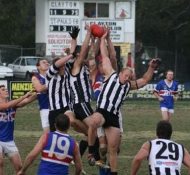A Multicultural Game For All To Share
- Tuesday, July 21 2015 @ 09:51 am ACST
- Contributed by: Wesley Hull
- Views: 2,249


The recent decision by the Victorian Government to partner with the AFL this year to promote the upcoming Multicultural Round will be a huge bonus for the uptake of the game across Australia. When Victorian Premier Daniel Andrews made the announcement last week that the state government would sponsor the weekend’s activities and promotions through funding from the Office of Multicultural Affairs and Citizenship, it became a game changer for the AFL’s hopes, plans and dreams. Events across Victoria would now have the funding to reach a greater audience.
Not only can the first ever AFL Multicultural Festival in Yarra Park go ahead as planned during the Round 19 AFL fixtures from 7th to 9th August, but Premier Andrews also launched a new social media campaign called “Embrace Diversity” which uses noted Australian football identities to spread the word of the Multicultural opportunities the game can offer. The full story regarding the partnership between the AFL and Victorian Government can be viewed at: http://www.afl.com.au/news/2015-07-16/afl-victorian-government-promote-special-round
To view the message of “Embrace Diversity”, go to: www.embracediversity.com
To find out more about the AFL’s Multicultural Round, go to the AFL website at: http://www.afl.com.au/multiculturalround
But whilst these projects go ahead to promote the game on a far wider scale nationally, there is also a time for private reflection on the place of our nation’s diverse ethnic, cultural, religious and belief backgrounds in the development of our national game.
The setting is 1971 at a suburban club in Melbourne – the Houghton Road Reserve was the home ground of the Mighty Clayton Magpies – or “The Holes” as they were called, which was a throwback to the urban legend that the club’s first set of donated jumpers came from Collingwood complete with moths and associated artwork.
My earliest memories were of a club which was built around a collection of predominantly Anglo-Celtic or Anglo-Saxon names such as Wallace, White, Clarke, Lyons, Morgan, Wells, Jewell and more. These were my young team mates in the Under 11 team. Clayton as a suburb was in the process of changing from a place on the fringe of market gardens to one of a denser suburban feel.
Part of that growth was the steady influx of European migrants to the suburb. This had already been growing steadily since the 1950’s as European families left their homes in Italy, Poland, Greece, Yugoslavia and Germany to start new lives. The growth of population hadn’t really impacted in a big way with local footy.
But as the decade moved on names like Fantoma, Kosten, Rineer began to decorate our list. Soon afterwards they would appear in our goalkicking list and before long the best players list. The trickle of interest kept growing until the Clayton playing lists boasted a huge variety of ethnic origin names. Some names remained locally specific, though the occasional name – like Silvio Foschini – managed to go further. A lot further.
By the late 1970’s the next influx of multicultural growth had taken hold with the Vietnam War seeing refugees arriving from Vietnam, Laos and Cambodia. Many moved to those same south-East Melbourne suburbs. Clayton’s neighbour, and respected on-field opponent, Springvale, became renowned as one of Australia’s largest South-East Asian communities. And once again the next generation of their kids ever so gradually started to take up our game.
For an assignment at university in 2003 I made contact with my old school, Clayton South Primary School on Clayton Road. I was keen to get a handle on the multicultural growth in the first place I clearly remember growing up. Sure enough, their figures were quite astonishing. At the time of my leaving Clayton for a different life down on the Mornington Peninsula (Sorrento) in 1974 the migrant kids numbered 12 percent. In my school days the old fashioned names of Wayne, Dave, John and Graeme were being replaced by Gulio, Claudie, Branco and Adriano. The girls also started moving from Wendy, Pauline and Jenny to Andrea, Daniella and Giovanna.
By 2003 – almost 30 years later – the school demographic had in excess of 80 percent of students from a diverse multicultural background. Down in Sorrento it wasn’t such a figure, though change inevitably continued for my whole time there.
In Sydney I played for the Macquarie warriors for a short while, but worked in Campsie. Part of Sydney’s south-western suburbs, the area of Campsie, Lakemba, Punchbowl, Bankstown was an enormous area of growth for various Middle East migrants from Lebanon especially but also other nations. Once again the migration was driven by the effects of war in their home nation, or a need to simply pursue a better life. Whilst these kids didn’t necessarily grow Australian Rules footy, they have grown up as supporters and players for Rugby League.
Today I live in Cairns in far North Queensland. A beautiful tropical city with a cosmopolitan population, largely built around the sugar and timer industries as well as the old gold rush days, Cairns also has a wealth of indigenous culture with both aboriginal and Torres Strait Islanders living in the city. Their kids have taken to our game. AFL Cairns proudly boasts enormous junior growth and much of that comes from the indigenous kids flocking to the game. My own club, Pyramid Power, boasts in excess of 90% indigenous kids.
Everywhere I have lived the forever growing and changing multicultural population has played a part in the growth of my homes and my footy. It is hard to imagine how far the game could have got without that multicultural growth. But I, for one, am grateful for that development in our nation and our game.
I will embrace the upcoming Multicultural Round celebrations with gusto and personal pride. I hope you will also.


 RSS news
RSS news Twitter
Twitter Facebook
Facebook